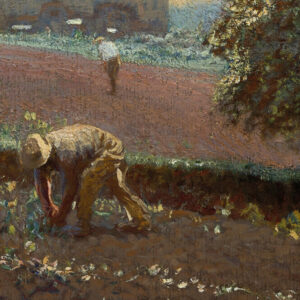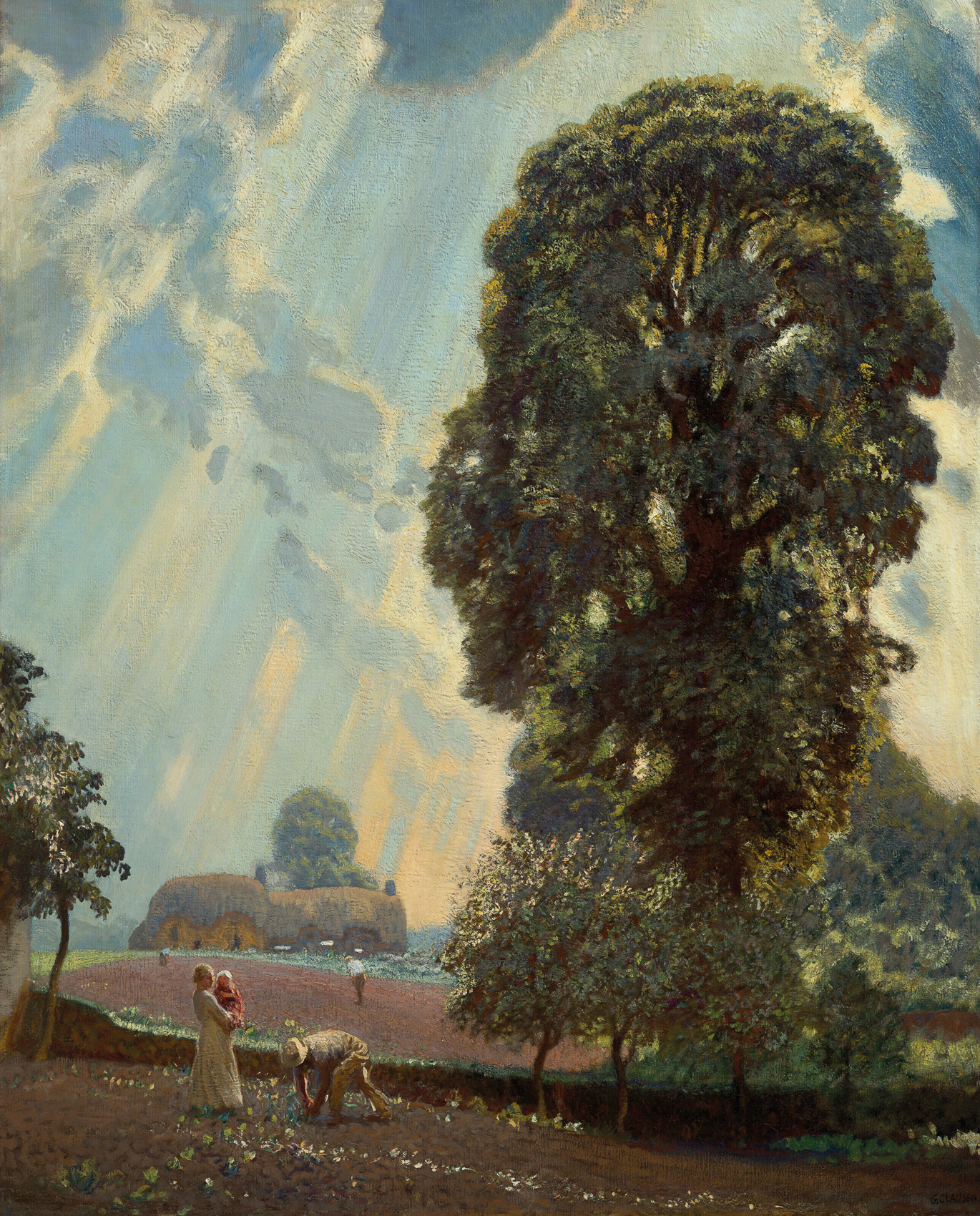Abundance & Burdens
The Colors of Summer

Mr. Hadden Turner
Finally, it is hot outside. The frosty mornings of early spring are a distant memory now that the sun lingers up high on its daily journey across the sky. As it drenches the ground with life-giving rays, the flowers that populate the front gardens of my neighborhood and the crops in the local allotment take full advantage of this infinite bounty of energy. Summer has arrived.
If spring heralded a burst of verdant green, summer heralds a burst of rainbow color. On the ancient country lanes near where I live, a diverse array of wildflowers line the banks — red campion, foxglove, speedwell, chickweed, and mallow — all proudly displaying their riotous colors, rivaling that of any domesticated flower show. Fluttering butterflies also abound, with their delicate, many-hued garb matching the beauty of the flowers from which they drink life-giving nectar. The early growth of spring has matured into its full and flourishing beauty, with all the hard work of springtime now bearing fruit in the midyear season of abundance. The diligent labors of protection, preparation, and nurture that the farmer and gardener have performed for their crops have yielded dividends. The plants, healthy and strong, are now eager and ready to channel their growth into the production of beauty, flavor, and progeny: flowers, fruits, and seeds. This is the ultimate outturn of summer — the maturation of springtime possibilities into full and delicious harvests.
This is the ultimate outturn of summer — the maturation of springtime possibilities into full and delicious harvests.
My tomatoes have been earnestly awaiting this moment in the year — it is their magnificent climax. The warmth and preponderance of summer light give crescendo to their rich flavors and colors, which rapidly develop once the warmest season has begun. Over a matter of days, the green fruits that once populated the garden burst into a spectrum of colors: bright red, golden yellow, and the rich brown of my prized ‘Chocolate Cherries.’ This color change signals the arrival of the exquisite flavors for which these heritage varieties have been skillfully bred. Biting on a fruit fresh from the vine, the warm acidic juices seep into your mouth like as much liquid sunshine. It may have taken many hours of work over the spring months to repot, fertilize, water, and protect these fruits, but this labor receives its ample reward. Throughout the summer, I receive a continual harvest from my many vines; the early cherry varieties begin to yield in the first few weeks of June while the larger varieties continue to yield even into the early autumn. Summer is a bountiful delight.
Yet the long, sunny days of midyear do bring their burdens and particular challenges. Drought is the all-too-common foe to summer’s bounty; without adequate rainfall and the shade that comes with it, livestock can become stressed by relentless heat and crops can wither. Some may die. In a paved suburban garden, precious plants grow in a multitude of pots, each needing to be individually watered. During the most intense of droughts, this laborious task must be undertaken twice a day, or blossom-end rot may strike with brutal vigor. There is nothing we can do once this rot has set into a fruit, except hope that the rest do not succumb.
 And even a summer rain is not always the relief one would hope it to be. When coupled with cooler temperatures in late summer, rain can bring untold destruction to a year’s hard work, which can be laid waste if these conditions lead to the setting in of blight. Indeed, blight ripped through my own little garden last year due to just such weather, ending a merciless season wherein drought and rain conspired to destroy most of my harvest.
And even a summer rain is not always the relief one would hope it to be. When coupled with cooler temperatures in late summer, rain can bring untold destruction to a year’s hard work, which can be laid waste if these conditions lead to the setting in of blight. Indeed, blight ripped through my own little garden last year due to just such weather, ending a merciless season wherein drought and rain conspired to destroy most of my harvest.
Alas, even if we are spared both drought and late, cool rains, the atmospheric conditions in summer are still ripe for another foe to descend upon us: that most devastating of rains, the thunderstorm. Just one storm has the potential to decimate a farmer’s crop in a single night. It is a desperately tragic moment, akin to falling at the last hurdle, for these storms are most common around the harvest time.
It is a desperately tragic moment, akin to falling at the last hurdle, for these storms are most common around the harvest time.
Summer is thus a time of finely balanced rhythms: too much rain spells disaster, too little rain likewise, and storms may bring too much force for any crop’s good. Yet “by the sweat of one’s brow” we must work for our bread (or our tomatoes), come what may. No easy life has been promised to us. Thus, we can also look upon the relationship between the weather and the harvest (or lack thereof) as a reminder: the farmer and the gardener — and everyone else as well — must daily exercise both strenuous work and steadfast trust. We are called to work the ground and tend its produce with all our skill and wisdom so that the land may yield abundantly. But the wise steward knows that on its own, this work is not enough.  No matter how hard we work, we cannot force the crops to grow healthy and strong — that work is in the Creator’s hands alone. Likewise, we cannot control the weather; we can only work alongside it, whatever it brings. But we can pray to and trust in the Maker, the Grower, and the One who can calm the storms with a mere word. And even if those storms are not calmed, even if the losses are painful, there is always hope to be found in the unwavering pronouncement that “while earth remains, seedtime and harvest . . . shall not cease.” The farmer can be sure: future abundance is promised, even if he does not always know when it will arrive.
No matter how hard we work, we cannot force the crops to grow healthy and strong — that work is in the Creator’s hands alone. Likewise, we cannot control the weather; we can only work alongside it, whatever it brings. But we can pray to and trust in the Maker, the Grower, and the One who can calm the storms with a mere word. And even if those storms are not calmed, even if the losses are painful, there is always hope to be found in the unwavering pronouncement that “while earth remains, seedtime and harvest . . . shall not cease.” The farmer can be sure: future abundance is promised, even if he does not always know when it will arrive.
And in the end, there is in most years great joy to be had, as our work on the land and the Grower in the heavens conspire to bring us lovely long summer evenings and a beautiful harvest. It is no wonder that summer is the season that many of us enjoy the most. Warm twilight gatherings out on the porch. Picnics and games in the park or on the beach. Swims in the river or the lake, and slow summer holidays. Even for those who work the land, late summer can provide a time for rest, for when the harvest is safely in the barn, the time arrives to finally enjoy the abundant fruits of the labor.
This is especially so if the year’s work has led to a coveted glut. In some years, the orchards or vegetable patches or wheat fields yield extraordinary amounts of fruit or grain, too much for one gardener or industrious home baker to deal with. It is what we call a glut — and the best way to deal with a glut is to share out the abundance amongst friends, family, and neighbors. Even the farmer, who will sell all that he can, makes space for the free sharing of this happy surplus with his fellow man. And, in my small way, this is certainly something that I relish doing with my tomatoes. My wife makes them into delicious chutneys and sauces to share with neighbors and friends — and although I may be biased, I’m certain their flavor far exceeds anything that can be bought in the supermarket. There is, though, an even better occasion to share our abundance, one we are particularly good at hosting here in Britain: festivals, fetes, and fairs.
Late summer is traditionally the time for harvest festivals, such as Harvest Home and the Harvest Frolic, days of celebration that occurred once the harvest was safely gathered in and farmers and farmhands alike could relax and enjoy the fruits of their labor. Lammas day, when a loaf made from the first fruits of the wheat harvest was brought to the parish church to be blessed, was also traditionally celebrated at this time. Though today we often delay our harvest celebrations until autumn, summer still remains a time characterized by feasting and festivity, when communities come together to share summer salads, pies, and cakes. In the Chelmsford neighborhood where I live, we are known for throwing wonderful parties where streets are closed to traffic and neighbors bring out their best dishes to share, taking time to eat together, relax together, and reminisce about years gone by.
But all too soon, the last days of summer draw near, and everything begins once again to slow down. The abundant heat and energy of the sunniest time of the year has made the land appear tired and worn out. Flowers wither and fade and the fields grow progressively empty as the final harvests are gathered in. Change is in the air; a new season, quieter and more meditative, is coming. And the leaves of the trees turn a darker shade of green, with the faintest tinges of yellow, orange, and brown starting to emerge at their edges, heralding the approaching fall.

